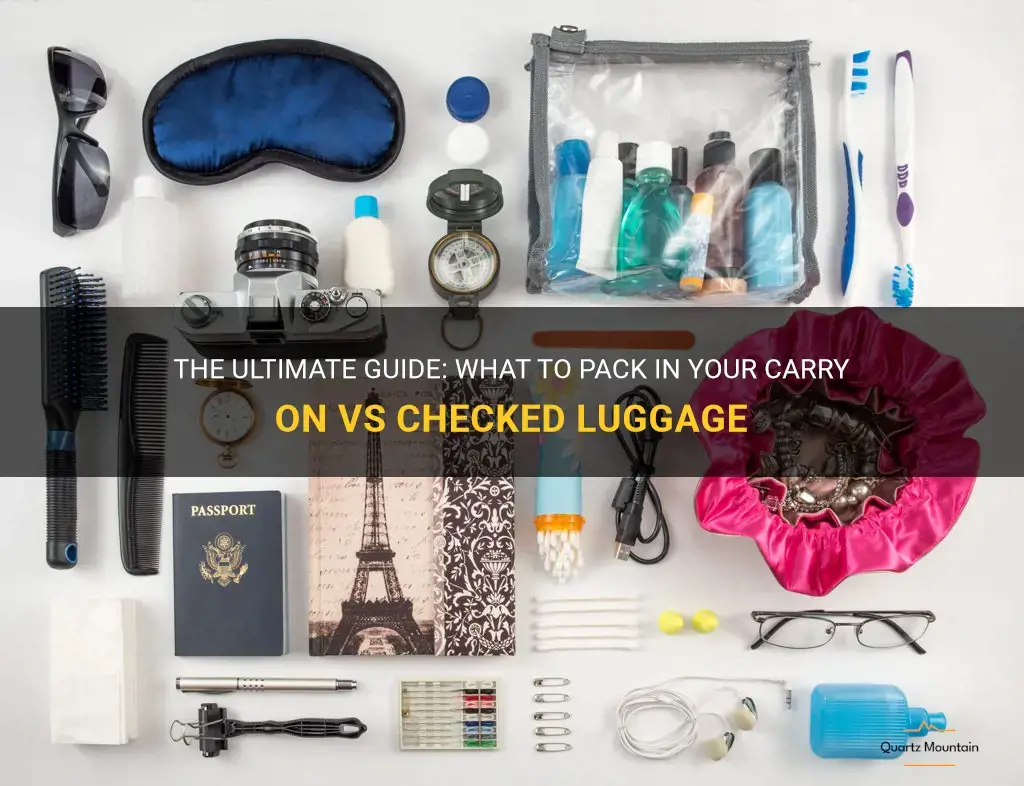
Traveling can be a wonderful and exciting experience, but figuring out what to pack can often be a daunting task. With so many restrictions and limitations, it can be difficult to determine what should go in your carry-on versus your checked luggage. That's why we've created the ultimate guide to help you navigate this packing conundrum and ensure that you have everything you need for your journey. Whether you're a seasoned traveler or embarking on your first trip, this guide will provide you with the knowledge and insight you need to pack efficiently and effectively. Say goodbye to overpacking and hello to stress-free travel with our comprehensive breakdown of what to pack in your carry-on versus checked luggage.
| Characteristics | Values |
|---|---|
| Bag Size | Carry On: Limited to specific dimensions, typically around 22 x 14 x 9 inches. Check with your airline for exact restrictions. Checked: Typically restricted to larger dimensions, often around 62 linear inches (length + width + height). Check with your airline for exact restrictions. |
| Weight Limit | Carry On: Usually limited to around 40 pounds, but can vary by airline. Check with your airline for exact restrictions. Checked: Generally has a higher weight limit, often around 50-70 pounds, but can also vary by airline. Check with your airline for exact restrictions. |
| Bag Accessibility | Carry On: Easy access to your belongings during the flight. You can keep your bag with you and access it whenever needed. Checked: Limited accessibility during the flight. Your bag will be stored in the cargo hold and you won't have access to it until you retrieve it upon arrival. |
| Fragile Items | Carry On: Recommended for fragile items such as electronic devices, medications, valuables, and delicate items. Checked: Not recommended for fragile items as they may get damaged or broken during handling and transportation. |
| Liquids | Carry On: Limited liquid restrictions, typically containers of 3.4 ounces or less per item and all items must fit in a clear, quart-sized bag. Checked: No liquid restrictions, but there may be limits on the total amount of liquid you can pack in your checked luggage. |
| Security Screening | Carry On: Must go through security screening at the checkpoint. You may be required to remove certain items, such as electronics and liquids, from your bag. Checked: Your bag will be screened by the Transportation Security Administration (TSA) or other security agencies. |
| Cost | Carry On: Usually free to bring on board, but some airlines may charge for larger or extra carry-on bags. Checked: Often has a fee associated with it, which can vary by airline and route. The cost may depend on the weight and number of checked bags. |
| Travel Essentials | Carry On: Recommended to pack essential items such as identification, travel documents, medication, electronics, extra clothes, and personal care items. Checked: Can pack non-essential items such as clothing, shoes, toiletries, and other travel accessories. |
What You'll Learn
- What are the essential items that should always be packed in a carry-on bag rather than checked luggage?
- Are there any restrictions or limitations on what can be packed in a carry-on bag versus checked luggage?
- How do the size and weight restrictions for carry-on bags differ from those for checked luggage?
- Are there any specific items or types of items that are more likely to be confiscated or limited in a carry-on bag compared to checked luggage?
- Are there any benefits or advantages to packing certain items in checked luggage instead of a carry-on bag?

What are the essential items that should always be packed in a carry-on bag rather than checked luggage?
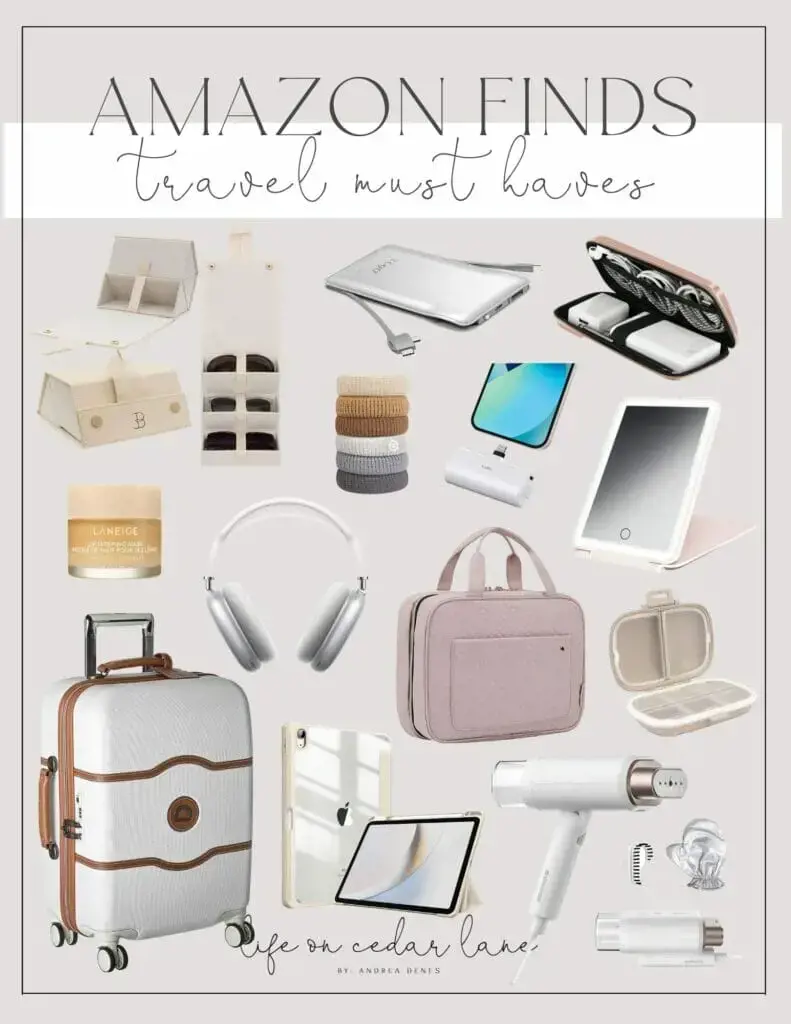
When packing for a trip, it is essential to consider what items should be packed in a carry-on bag rather than checked luggage. A carry-on bag is the bag that you will take with you onto the airplane and keep with you throughout the flight. It is important to pack essential items in your carry-on bag in case your checked luggage is lost or delayed. Here are some essential items that should always be packed in a carry-on bag:
- Travel Documents: It is crucial to keep your travel documents in your carry-on bag. This includes your passport, ID, visa, boarding pass, and any other necessary documents. Losing your travel documents can be a major inconvenience when traveling, so it is best to keep them in a secure and easily accessible place.
- Medications: If you take any medications regularly, it is important to pack them in your carry-on bag. This ensures that you have access to your medications during the flight and in case your checked luggage is lost or delayed. It is recommended to pack your medications in their original containers with the prescription label.
- Electronics: Many people travel with their electronic devices, such as laptops, tablets, and smartphones. These items are expensive and valuable, so they should always be packed in a carry-on bag rather than checked luggage. Additionally, electronic devices can provide entertainment during the flight.
- Valuables: If you are traveling with any valuable items, such as jewelry, cash, or important documents, it is best to keep them in your carry-on bag. Losing these items can be devastating, so it is important to keep them with you at all times during the flight.
- Change of Clothes: In case your checked luggage is lost or delayed, it is a good idea to pack a change of clothes in your carry-on bag. This way, you will have something to wear until your luggage is located or resolved.
- Toiletries: It is a good idea to pack a small bag of toiletries in your carry-on bag. This can include items such as toothbrush, toothpaste, deodorant, and a travel-sized bottle of shampoo. These items can be useful during a long flight or in case your checked luggage is delayed.
- Snacks: Airline food may not always meet your dietary needs or preferences, so it is beneficial to pack some snacks in your carry-on bag. This can include items such as energy bars, nuts, or dried fruits. Having snacks on hand can also be helpful in case of a long delay or layover.
- Entertainment: If you anticipate a long flight, it can be helpful to pack some forms of entertainment in your carry-on bag. This can include books, magazines, puzzles, or a portable gaming device. Having something to keep you entertained can make the flight more enjoyable.
In conclusion, when packing for a trip, it is important to consider what items should be packed in a carry-on bag rather than checked luggage. Essential items such as travel documents, medications, electronics, valuables, a change of clothes, toiletries, snacks, and entertainment should always be packed in a carry-on bag. By packing these items in your carry-on bag, you can be prepared for any situation and ensure a smooth and enjoyable journey.
Essential Items to Pack for Your Puerto Vallarta Vacation
You may want to see also

Are there any restrictions or limitations on what can be packed in a carry-on bag versus checked luggage?
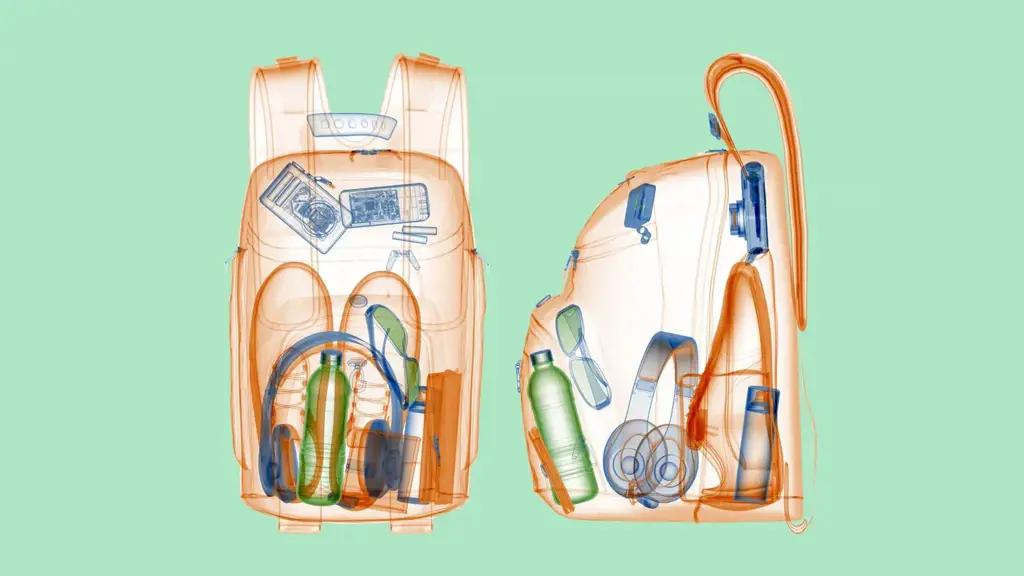
When it comes to traveling, understanding the restrictions and limitations on what you can pack in your carry-on bag versus your checked luggage is crucial. It ensures that you meet the regulations set by airlines and transportation agencies and helps make your journey smooth and hassle-free.
Carry-on luggage refers to the bags or suitcases that passengers are allowed to bring with them onboard the aircraft. These bags are typically stored in an overhead bin or under the seat in front of the passenger. On the other hand, checked luggage is the baggage that is handed over to the airline at the check-in counter and is stored in the cargo hold of the aircraft.
While there are general guidelines that apply to all airlines, it's important to note that specific restrictions and limitations may vary between airlines and travel destinations. However, there are some common items that are generally prohibited or have limitations when it comes to carry-on bags:
- Liquids: The Transportation Security Administration (TSA) has established the "3-1-1" rule, which means that liquids, gels, and aerosols in containers should be in a 3.4-ounce (100 milliliters) container or smaller. These containers should be packed in a clear, quart-sized plastic bag, with one bag per passenger. Certain exceptions apply for medications, baby formula, and breast milk.
- Sharp objects: Items such as knives, scissors, blades, and sharp tools are generally not allowed in carry-on bags. However, they may be allowed in checked luggage as long as they are properly secured.
- Sporting goods: Many sporting goods, such as baseball bats, golf clubs, and hockey sticks, are not allowed in carry-on bags due to their potential to be used as weapons. These items are typically allowed in checked luggage.
- Firearms and ammunition: Guns, firearms, and ammunition are strictly prohibited in carry-on bags. If you need to transport firearms or ammunition, you must declare them to the airline and follow specific guidelines for packing and checking them as separate items.
- Hazardous materials: Certain hazardous materials, such as flammable liquids, explosives, and corrosive substances, are strictly prohibited in both carry-on and checked luggage. These materials pose a threat to the safety of the aircraft and passengers.
In addition to these specific restrictions, there are some general considerations when it comes to packing in both carry-on and checked luggage:
- Space limitations: Carry-on bags usually have limited space compared to checked luggage. It's important to pack efficiently and prioritize essential items in your carry-on bag, such as travel documents, medications, and valuables.
- Weight restrictions: Airlines often have weight restrictions for both carry-on and checked luggage. Exceeding these limits may result in additional fees or the need to repack your belongings.
- Fragile items: Fragile items should be properly protected to prevent damage during handling. It's recommended to pack them in your carry-on bag if possible, to ensure they are handled with care.
- Security screening: Both carry-on and checked luggage are subject to security screening. It's important to pack in a way that allows for easy inspection, such as placing liquids in a separate bag and removing laptops or large electronic devices from your bag for separate screening.
Understanding the restrictions and limitations on what can be packed in a carry-on bag versus checked luggage is essential for a stress-free travel experience. It's recommended to check the specific guidelines provided by your airline and the TSA or relevant transportation agency before packing to ensure compliance with all regulations.
Essential Items to Include in Your Desert Packing List
You may want to see also

How do the size and weight restrictions for carry-on bags differ from those for checked luggage?
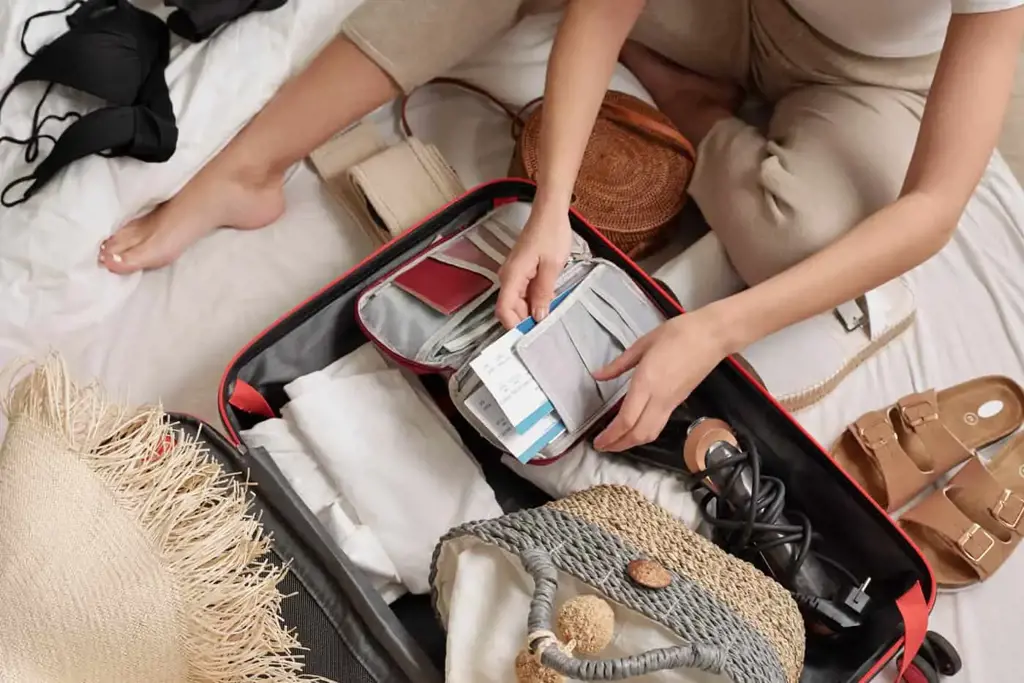
When it comes to traveling, whether for business or pleasure, packing efficiently is key. Understanding the size and weight restrictions for your carry-on and checked luggage can help ensure a smooth and hassle-free travel experience.
Carry-On Bag Restrictions:
Carry-on bags are those that are allowed to be brought onto the aircraft and stored in the overhead compartments or under the seat in front of you. These bags are subject to specific size and weight limitations, as defined by the airline you are flying with.
- Size Restrictions: Different airlines have different size restrictions for carry-on bags, usually measured in linear inches. For example, most domestic airlines in the United States allow carry-on bags that are no larger than 22 inches long, 14 inches wide, and 9 inches tall. It's important to check with your airline beforehand to ensure your bag meets their size requirements.
- Weight Restrictions: In addition to size restrictions, airlines also have weight restrictions for carry-on bags. These restrictions vary depending on the airline and the class you are flying in. As a general rule of thumb, most airlines allow carry-on bags to weigh between 15 to 25 pounds. It's important to check with your specific airline to verify their weight restrictions.
Checked Luggage Restrictions:
Checked luggage refers to the bags that are checked in at the airport's check-in counter and are stored in the aircraft's baggage compartment. These bags may have different size and weight restrictions compared to carry-on bags.
- Size Restrictions: Checked luggage typically has larger size allowances compared to carry-on bags. While carry-on bags are subject to size restrictions to fit in the overhead compartments or under the seat, checked luggage can be larger overall. However, airlines still have specific size limits for checked bags to ensure they fit in the aircraft's cargo hold and do not pose any safety risks.
- Weight Restrictions: Checked luggage also has weight restrictions, typically higher than those for carry-on bags. Depending on the airline and the class you are flying in, checked bags can have weight limits ranging from 50 to 70 pounds. It's important to check with your airline to verify their specific weight restrictions for checked luggage.
It's important to note that these size and weight restrictions can vary significantly between different airlines and even different flights within the same airline. It's always a good idea to check with your specific airline before traveling to ensure you comply with their size and weight restrictions.
Failing to comply with these restrictions can result in additional fees, having to check in your carry-on bag as checked luggage, or even being forced to leave items behind. By understanding and adhering to these restrictions, you can save yourself time, money, and any potential headaches during your travels.
In summary, carry-on bags have smaller size and weight restrictions compared to checked luggage. Carry-on bags must fit in the overhead compartments or under the seat, while checked bags have more leeway in terms of size. Additionally, checked bags can typically weigh more than carry-on bags. It's important to check with your airline to understand their specific size and weight restrictions to avoid any issues during your journey.
Essential Packing List for Your Rocky Mountain National Park Adventure
You may want to see also

Are there any specific items or types of items that are more likely to be confiscated or limited in a carry-on bag compared to checked luggage?

When it comes to packing for a flight, it is important to be aware of the restrictions on carry-on luggage. While most items are allowed in either checked or carry-on bags, there are certain items that are more likely to be confiscated or limited in a carry-on bag compared to checked luggage.
One of the main reasons certain items are restricted in carry-on bags is due to the Transportation Security Administration (TSA) regulations. The TSA has strict rules in place to ensure the safety of all passengers. These rules are designed to prevent potential threats or hazards aboard an aircraft.
One example of an item that is more likely to be confiscated in a carry-on bag is liquids. The TSA restricts the amount of liquids that can be carried in a carry-on bag to containers that are 3.4 ounces (100 milliliters) or less. These containers must also be placed in a clear, quart-sized plastic bag. Any liquids that exceed this limit will be confiscated at the security checkpoint. However, there are no restrictions on liquids in checked bags. This is because the checked bags go through additional screening processes that allow for a more thorough examination of the contents.
Another example of an item that is more likely to be restricted in a carry-on bag is sharp objects. The TSA prohibits various sharp objects, such as knives, scissors, and razor blades, in carry-on bags. These items can be considered potential weapons and can pose a safety risk onboard an aircraft. However, these sharp objects can be packed in checked luggage. It is important to note that there are specific rules and regulations on the size and type of sharp objects that are allowed in checked bags. It is always best to check the TSA website or contact the airline directly to ensure compliance with these regulations.
There are also certain items that are more likely to be limited in carry-on bags, rather than confiscated. For example, if you are traveling with large quantities of medications, it is advisable to pack them in your checked luggage and carry a smaller, travel-size portion in your carry-on bag. This is because the TSA allows passengers to carry a reasonable amount of medication in their carry-on bags, but may request additional documentation or verification for larger quantities.
Overall, while there are restrictions on certain items in carry-on bags, it is important to remember that these regulations are in place for the safety and security of all passengers. It is always best to check the TSA website or contact the airline directly for the most up-to-date information on what can and cannot be carried in your carry-on bag. By being aware of these restrictions, you can ensure a smoother and hassle-free travel experience.
Ultimate Packing Guide for Your Bermuda Vacation
You may want to see also

Are there any benefits or advantages to packing certain items in checked luggage instead of a carry-on bag?
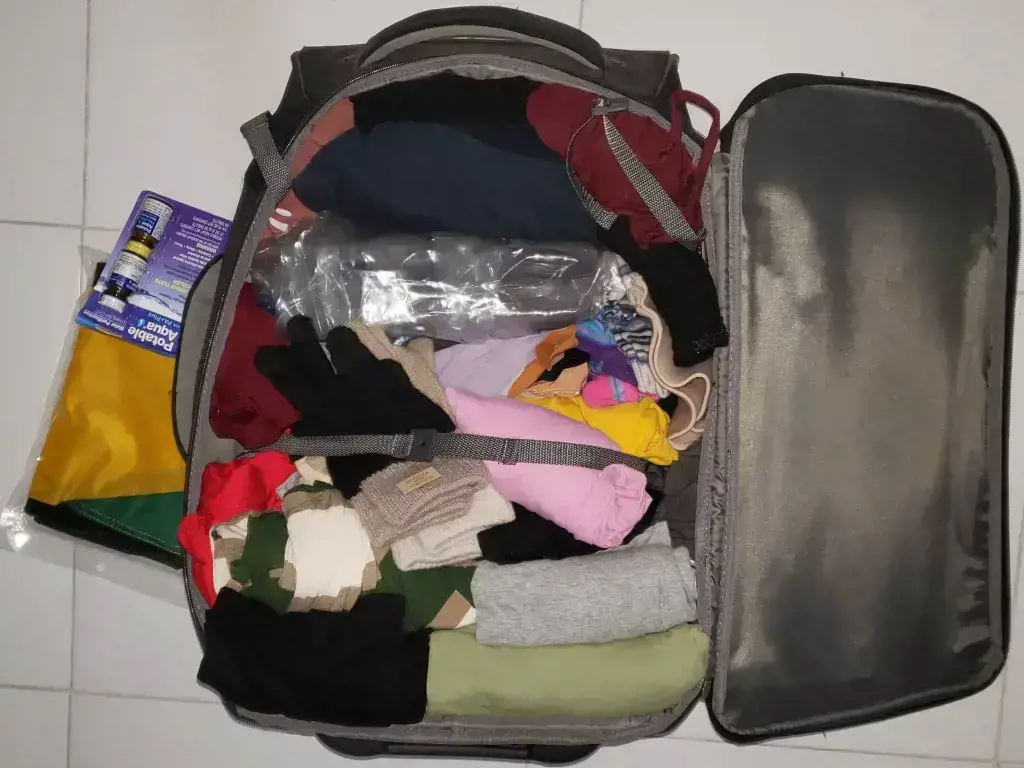
There can be several advantages to packing certain items in checked luggage instead of a carry-on bag when traveling. While many travelers prefer to bring all their belongings in a carry-on bag to avoid the hassle of checking in luggage, there are situations where it may be more beneficial to utilize the checked luggage option.
Firstly, one of the main advantages of packing certain items in checked luggage is the ability to bring larger or more bulky items. With the restrictions on size and weight for carry-on bags, it can be difficult to bring items such as souvenirs, clothes for different climates, or sports equipment. By checking these items in your luggage, you can bring more variety and have the freedom to explore different activities during your trip.
Another benefit of packing certain items in checked luggage is the convenience and ease of movement during the journey. Carrying a heavy or bulky bag throughout the airport and onto the plane can be tiring and tedious. By checking in larger items, you can navigate through the airport with ease, giving you more energy to enjoy your travel experience.
Additionally, there are certain items that are not allowed in carry-on bags due to airport security regulations. These items include sharp objects, such as knives or scissors, and liquids in containers larger than 3.4 ounces. If you need to bring such items, it is necessary to pack them in your checked luggage to avoid any issues at the security checkpoint.
Furthermore, packing certain items in checked luggage can also provide a greater level of security for valuable or fragile items. Carry-on bags are often handled more roughly and are subject to more frequent searches at security checkpoints. By packing valuable or delicate items in your checked luggage, you can minimize the risk of damage or loss.
Lastly, by separating certain items into checked luggage, you can reduce the weight and size of your carry-on bag, making it easier to store it in the overhead compartments. This can be particularly helpful on flights with limited overhead space or when you have multiple bags to carry.
In conclusion, while carry-on bags offer convenience and speed during travel, there are several benefits to packing certain items in checked luggage. The ability to bring larger or more bulky items, the convenience of movement, adherence to security regulations, increased security for valuable or fragile items, and easier storage options are all advantages of utilizing checked luggage. Consider your travel needs and the specific items you need to bring before deciding how to pack for your next trip.
Essential Items to Pack for a 5-Day Cruise to Cozumel
You may want to see also
Frequently asked questions
When packing your carry-on bag, it's important to include essential items that you may need during your flight or in case your checked luggage gets lost. Some common items to pack in your carry-on include your passport and travel documents, medications, a change of clothes, toiletries, electronic devices and chargers, and any valuable or fragile items that you don't want to risk being damaged or lost.
Your checked luggage should primarily contain items that you won't need immediate access to during your flight. This can include clothing, shoes, and bulkier items such as coats or jackets that you may not want to carry around in your carry-on bag. It's a good idea to also pack any liquids, gels, or aerosols that exceed the size limit for carry-on liquids in your checked luggage to avoid any issues at security.
Yes, you can bring food in both your carry-on and checked luggage. However, there are some restrictions to keep in mind. In your carry-on, you can bring solid food items such as sandwiches, fruits, and snacks. Liquids, sauces, and spreads that are larger than 3.4 ounces or 100 milliliters must be placed in your checked luggage. It's important to double-check any specific restrictions or regulations for bringing food items when traveling to your destination, as some countries may have specific rules regarding the importation of certain foods.







